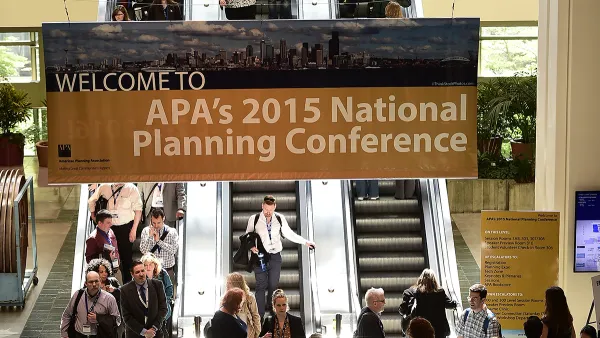A session at the recent APA National Conference in Chicago gathered together the heads of the major built-environment professional organizations to discuss their unique and shared challenges. One subject was on each head's mind: Water.
What is the most critical issue designers don't even know exists? "According to the heads of the major built-environment design organizations, the American Society of Landscape Architects (ASLA), the American Institute of Architects (AIA), and the American Planning Association (APA), it’s water," says Jared Green, who recaps the Presidents Forum held at the recent APA National Conference.
"Water is going to become increasingly scarce. It’s particularly a problem in the United States as many of the highest growth areas are in parts of the country that are already stressed with water shortages. Worldwide, countries are struggling with diminishing ground water resources and some are even worried about water wars. Mitchell Silver, the outstanding (and unfortunately outgoing) president of APA, said 'water is going to make oil look minor league.'” This was among the critical insights provided at the unique gathering of design profession luminaries that included Mark Focht, FASLA and Jeffrey Potter, FAIA.
Other prominent issues confronting each field:
ASLA: "The focus of the next few years will be pushing for land and water conservation, community parks, a national complete streets program, more federal support for green infrastructure, and benefits for small businesses."
AIA: "Potter said the architecture practice was in a state of transformation. He said the world is struggling with how to create 'place-based knowledge in a digital era'....In this new world, architects are increasingly focused on 'high performance places, public health, and disaster mitigation.'”
APA: "With 40,000 members in 90 countries, APA is also concerned about global issues like climate change, population growth, urbanization, and suburbanization....The future then is about 'comprehensive planning' to ensure communities are more 'adaptable and resilient' to changes, whether they are due to population growth, water shortages, economic change, climate shifts, or natural disasters."
FULL STORY: What Is the Most Critical Issue Designers Don’t Even Know Exists?

Analysis: Cybertruck Fatality Rate Far Exceeds That of Ford Pinto
The Tesla Cybertruck was recalled seven times last year.

National Parks Layoffs Will Cause Communities to Lose Billions
Thousands of essential park workers were laid off this week, just before the busy spring break season.

Retro-silient?: America’s First “Eco-burb,” The Woodlands Turns 50
A master-planned community north of Houston offers lessons on green infrastructure and resilient design, but falls short of its founder’s lofty affordability and walkability goals.

Test News Post 1
This is a summary

Analysis: Cybertruck Fatality Rate Far Exceeds That of Ford Pinto
The Tesla Cybertruck was recalled seven times last year.

Test News Headline 46
Test for the image on the front page.
Urban Design for Planners 1: Software Tools
This six-course series explores essential urban design concepts using open source software and equips planners with the tools they need to participate fully in the urban design process.
Planning for Universal Design
Learn the tools for implementing Universal Design in planning regulations.
EMC Planning Group, Inc.
Planetizen
Planetizen
Mpact (formerly Rail~Volution)
Great Falls Development Authority, Inc.
HUDs Office of Policy Development and Research
NYU Wagner Graduate School of Public Service



























